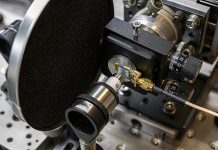
For the first time ever, scientists have directly observed hydrogen and oxygen atoms combining to form nanoscale water bubbles in real time.
This groundbreaking discovery, made by researchers at Northwestern University, could have major implications for creating water in arid environments and even in space.
The study, published in Proceedings of the National Academy of Sciences, focused on how the metal palladium acts as a catalyst to produce water.
Palladium has long been known to assist in water generation, but until now, scientists didn’t fully understand how the process worked at the molecular level.
Led by Professor Vinayak Dravid and his team, the researchers used a new technique to watch the formation of water molecules at the nanoscale.
This was made possible by an advanced technology they developed, which allows for the real-time visualization of gas reactions inside a special membrane.
“By being able to directly observe how water forms at this tiny scale, we’ve identified the best conditions for rapidly generating water at normal room conditions,” Dravid explained.
“This could be a game-changer for creating water in dry areas or even in deep space environments, without needing extreme temperatures or pressure.”
The research team’s new tool involves an ultra-thin glass membrane that holds gases inside nanoreactors, making it possible to view reactions in high detail.
This method lets scientists observe the movement and interaction of atoms at a resolution far better than previously available technologies.
While observing the reaction, the team saw hydrogen atoms enter the palladium, causing its structure to expand.
Then, they witnessed the formation of tiny water bubbles on the palladium’s surface—the smallest bubbles ever seen.
The researchers used advanced techniques to confirm that the bubbles were indeed water by analyzing the energy lost from scattered electrons, which revealed unique water-oxygen bonds.
Next, the team worked to optimize the reaction. They found that the fastest way to generate water was by first adding hydrogen, which the palladium absorbed, and then introducing oxygen. The reaction caused hydrogen to escape from the palladium and combine with the oxygen to create water.
Looking ahead, the researchers believe their findings could have practical uses in space travel. By preparing hydrogen-filled palladium sheets before a mission, astronauts could simply add oxygen to generate water, whether for drinking or plant growth. Although palladium is costly, it is reusable, and the process does not consume the metal—only the gases are used up.
“Our process can be repeated over and over with the same palladium, and hydrogen, the most abundant gas in the universe, can fuel the system,” said Yukun Liu, a Ph.D. candidate and lead author of the study.
This discovery brings us closer to sustainable water generation solutions, whether on Earth or in outer space.



